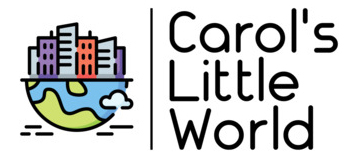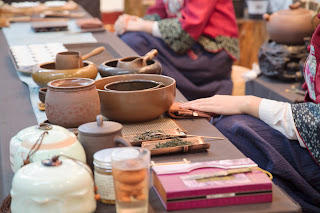We left off last time with me telling you a bit about Kevin and how I had attended a tea ceremony. The full tasting ceremony takes five hours and is quite complicated. The people serving the tea have to take a special bath and put their hair up a certain way. It was explained to us how this is done and then they told us we would be getting a shorter ceremony. We were happy about that, although I can only imagine how much fun the longer one would be.
For our tasting, we had three different teas to try. One was a mountain yellow tea. It was very light, even our host called it a sort of “ladies tea” due to it being very light. I liked it but did get a sense it was quite light. The next tea was osmanthus tea which is made by mixing in the local osmanthus flowers (these are the flowers local to Guilin.) We were told the first tea had monk fruit in it and the second tea was sort of like the monk fruit tea only with the osmanthus flowers mixed in. The last tea we tried was a brick tea. These type of teas are stronger, very strong in fact, and good for losing weight. I found it to be very good, I rather liked the brick tea but then I am a tea drinker and not shy of a stronger tea. Kevin said they drink the brick tea in Mongolia, in parts north, and in places like Tibet. It’s colder in these locations and they cannot get fresh teas there year round. Also, it’s hardy for them to drink. You can re-use the tea bricks, something like four or five times. To use a tea brick, we were told, cut it and break off a piece of the brick. One portion is about the size of your thumb’s fingernail.
It was explained to us how you should always “wash” tea with warm water. You dip the tea in water and pour the water off, then allow the tea to steep. It’s better that way. In the picture above, the small pots are placed inside the larger pots as they “wash” the tea in this way. It brings out the flavor of the tea.
Tea has more caffeine than coffee but, with tea, we do not eat the leaves of the plant so our bodies do not absorb the caffeine. With coffee, you eat the plant so you’re basically eating the caffeine, which is why it “works” on us as a stimulant. Even though tea technically has more caffeine, drinking a cup of tea is about equivalent to taking a short nap. It’s refreshing if you do it correctly. Tourist tea or “teabag” tea is typically made from older leaves. In China, they do not use many tea bag teas and it’s considered not as desirable. I have always preferred loose tea but I am such a tea drinker that I will grudgingly admit a tea bag is better than no tea at all. We were also told that a “lazy teacup” is like a strainer for loose tea-it’s kind of an all in one type deal for the office or for when you are being “lazy” and don’t want to mess with an entire pot. This is how I typically enjoy my tea. Even if you use a “lazy teacup” you should still rinse you tea. (It will still taste better.)
Next up, were we told how to hold the teacup for tasting. A woman holds the teacup with one hand, using her first and third (thumb and middle) fingers, with her smallest finger on the bottom of the cup. Using the other hand, she extends her index finger to meet the finger from her other hand on the bottom of the cup. She also puts together her first and third fingers to meet the other hand.
Regardless of gender, the tasting cup must be finished in three sips, no more no less. You do not say “thank you” when being served tea, rather you tap the table with your fingers straight and extended. They told us you tap one finger if you are single and two fingers if married. The entire ceremony is a wonderful tradition and I’m so happy to have experienced it. It’s one of those bucket list items for me. I’ll now forever be able to see “I once picked tea in China and got to attend a tea tasting ceremony.” I mean, really, how can you beat that, right? Especially for somebody like me who is really quite a tea drinker, it was a wonderful experience. The tea place we visited was wonderful and highly recommended. It’s called the Guilin Tea Research Institute. You can read more about them on their link: http://www.guilintea.com/. They also ship tea directly to the United States (and around the world) and they take PayPal so it’s pretty easy if you want to order yourself some tea from Guilin.
The bus out to the tea place was kind of fun itself. The neighborhood was more suburban, where real people live and a lot less touristy than parts of the downtown Guilin areas (there are very touristy areas in Guilin.) It was really great to see that as well. I saw a Honda car like mine and somebody out walking a dog. Little things like this that make for a wonderful exchange. Of course, the folks at the tea institute were very well versed in all things tea.
Until next time…
PS This image taken inside the tea ceremony. You can see the bowls they use for rinsing and then later serving the tea.

